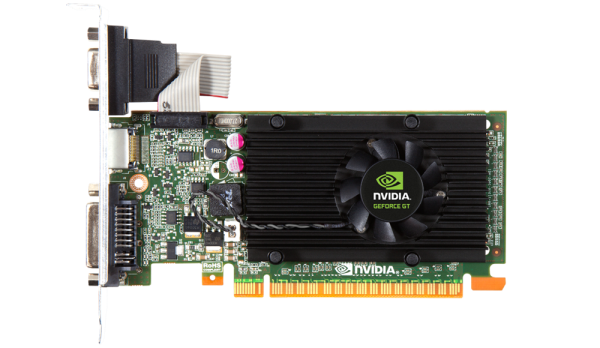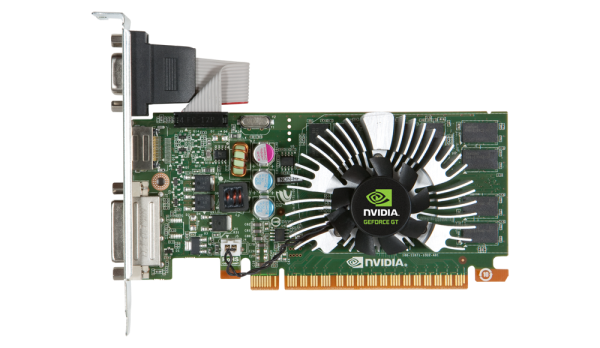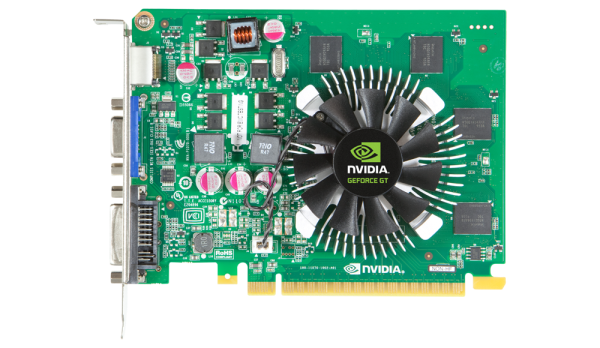NVIDIA Launches Fermi Based GeForce GT 610, GT 620, GT 630 Into Retail
by Ryan Smith on May 19, 2012 8:00 PM ESTWhile we were off at NVIDIA’s GTC 2012 conference seeing NVIDIA’s latest professional products, NVIDIA’s GeForce group was busy with some launches of their own. The company has quietly launched the GeForce GT 610, GT 620, and GT 630 into the retail market. Unfortunately these are not the Kepler GeForce cards you were probably looking for.
| GT 630 GDDR5 | GT 630 DDR3 | GT 620 | GT 610 | |
| Previous Model Number | GT 440 GDDR5 | GT 440 DDR3 | N/A | GT 520 |
| Stream Processors | 96 | 96 | 96 | 48 |
| Texture Units | 16 | 16 | 16 | 8 |
| ROPs | 4 | 4 | 4 | 4 |
| Core Clock | 810MHz | 810MHz | 700MHz | 810MHz |
| Shader Clock | 1620MHz | 1620MHz | 1400MHz | 1620MHz |
| Memory Clock | 3.2GHz GDDR5 | 1.8GHz DDR3 | 1.8GHz DDR3 | 1.8GHz DDR3 |
| Memory Bus Width | 128-bit | 128-bit | 64-bit | 64-bit |
| Frame Buffer | 1GB | 1GB | 1GB | 1GB |
| GPU | GF108 | GF108 | GF108/GF117? | GF119 |
| TDP | 65W | 65W | 49W | 29W |
| Manufacturing Process | TSMC 40nm | TSMC 40nm | TSMC 40nm | TSMC 40nm |
As NVIDIA was already reusing Fermi GPUs for GeForce 600 series parts for the OEM laptop and desktop market, it was only a matter of time until this came over to the retail market, and that’s exactly what has happened. The GT 610, GT 620, and GT 630 are all based on Fermi GPUs, and in fact 2 of them are straight-up rebadges of existing GeForce 400 and 500 series cards. Worse, they’re not even consistent with their OEM counterparts – the OEM GT 620 and GT 630 are based off of different chips and specs entirely.
At the bottom of the 600 series retail stack is the GeForce GT 610, which is a rebadge of the GT 520. This means it’s either a GF119 GPU or cut-down GF108 GPU featuring a meager 48 CUDA Cores and a 64bit memory bus, albeit with a low 29W TDP as a result. This is truly a rock bottom card meant to be a cheap as possible upgrade for older computers, as even an Ivy Bridge HD4000 iGPU should be able to handily surpass it.
The second card is the GT 620, which is a variant of the OEM-only GT 530. With 96 CUDA cores we’re not 100% sure that this is GF108 as opposed to the 28nm GK117, but as NVIDIA currently has a 28nm capacity bottleneck we can’t see them placing valuable 28nm chips in low-end retail cards. Furthermore the 49W TDP perfectly matches the GF108 based GT 530. Compared to the OEM GT 620 the retail model has twice as many CUDA cores, so it has twice as much shader performance on paper, but because of the 64bit memory bus it’s going to be significantly memory bandwidth starved.
The final new 600 series card is the GT 630, which is a rebadge of the GT 440. Like the GT 440 this card comes in two variants, a model with DDR3 and a model with GDDR5. Both models are based on GF108 and have all 96 CUDA cores enabled, and have the same core clock of 810MHz. At the same time this is going to be the card that deviates from its OEM counterpart the most. The OEM GT 630 was a Kepler GK107 card, so this rules out getting a Kepler based GT 630 retail card any time in the near future.
As always, rebadging doesn’t suddenly make a good card bad – or vice versa – but it’s disappointing to once again see this mess transition over to the retail market. We hold to our belief that previous generation products are perfectly acceptable as they were, and that the desire to have yearly product numbers in an industry that is approaching 2 year product cycles is silly at its best, and confusing at its worst.













44 Comments
View All Comments
Taft12 - Friday, May 25, 2012 - link
For volume yes, but the profit margin is tiny.It might take 100 sales of the GT 610 to equal the profit on a single GTX 680 sale.
shriganesh - Monday, May 21, 2012 - link
That's just plain cheating! It can't be accepted! They can't argue the performance level is same. TDP, new features (directX, openGL), 28nm etcMrSpadge - Monday, May 21, 2012 - link
+1marc1000 - Monday, May 21, 2012 - link
Nvidia sells marketing. They build the biggest/fastest chip to create hype and then sell whatever small chip they got in stock because a lot of people thinks that a GT630 card will run a game like the 680 card, because they are from the same company.I am still waiting for a U$ 200/250 card on 28nm and 150w TDP from nvidia to choose between it and the AMD cards. Unfortunately, AMD has a 28nm gpu on the market on that price but Nvidia doesn't, so my choice is still AMD.
The sad part is that AMD went for compute this generetion and Nvidia did an unexpected move going for raw performance on the 680 and won the race too soon. So the best card of this generation is one that does not exist. :-\
wiyosaya - Monday, May 21, 2012 - link
"Nvidia sells marketing."Agreed! It is marketing bling, and IMHO, they are doing it too often. Like $2,500 tesla cards so that you can get the double-precision compute performance that should be in the 680.
CeriseCogburn - Saturday, May 26, 2012 - link
Well, there's a whole lot of jelly spewing from you two.Too bad amd is a failing and bailing and firing hole of losses, unable to pay for driver teams let alone fly 200 people all over the world 24/7/365 to gaming companies to make our PC gaming experiences better.
Amd uses a telephone and email to "help gaming companies" that's how pathetic and broke they are - ROFL.
In fact, if they had a clue, they'd listen to you two, if even a tenth of your hate filled diatribe repeated as often as the sun rises against nVidia is remotely true, it's sound advice for actions amd needs to implement immediately, if not sooner.
Instead, we have amd failing, flailing, and driver teams bailing out the sinking ship, always behind, always unable to get to stable. They're like a broken addict with a dysfunctional lifestyle.
The reason nVidia can sell craploads of cards to OEMs and shelf markets is because they have a great reputation and their driver bundles are awesome - absolutely spectacular - and so simple to not screw up - so easy to fix if anything like a virus chews through them - that's a huge value for OEMs and end users.
It's huge.
It's huge for tech support costs - as in costs very little.
It's huge for entrepreneurial techies who can make a proifitable upgrade for their customers, quick, easy, and error free and without future troubles.
There's a LOT of REASONS beyond your spewing hatred, ones amd should take note of and attempt in vain to duplicate.
medi01 - Monday, May 21, 2012 - link
Logic they do have.Let's sell moar and who cares if we deceive customer quite a bit.
Most buyers wouldn't notice the difference anyway.
CeriseCogburn - Saturday, May 26, 2012 - link
Most buyers will be greatly pleased when they stuff their $30-$40 pci-E card in the slot and surpass their Intel or ATI integrated by 600% in performance.Something I know you smart guys always think about when talking about the deceived idiot consumers, none of which of course are ever you, here.
ROFL - yes you guys are so schmart !
ericore - Monday, May 21, 2012 - link
Graphics chip manufacturers aren't making tons of money, and if you can get away with selling rebranded chips to OEMs and uneducated consumers then by all means. Still, not everyone wants to shell out over a hundred for a graphics card; it's an undesired precedent since it states you must pay over X amount for new technology. A more eloquent way of doing it, is have limited stock on next gen low end since you'll want the more advanced tech for high end cards anyways, and when you run out of stock for your new gen low ends, then sell the rebranded version. And to sweeten the deal, as far as OEMs are concerned just sell them rebrands haha.CeriseCogburn - Saturday, May 26, 2012 - link
tipoo below has a tip for you" Low end performance hardly changes generation to generation "
I'm sure he's still enjoying his pci x300 by the way.